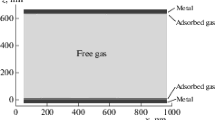Abstract
The work is devoted to supercomputer molecular modeling of gas dynamic spraying of nanoparticles on the substrate. The urgency of this problem is related to the development of production technologies for promising nanocoatings and nanomaterials. The observed increase in the power of modern computer and supercomputer systems makes it possible to use mathematical models based on the first principles in numerical experiments. One of such models is the molecular dynamics method. In this paper, a new results of using of direct molecular simulation for calculating of the acceleration of a nickel nanocluster by a nitrogen flow are presented. The data obtained in the calculations allow to optimize the parameters of the accelerating gas system and predict the speed characteristics of the nanocluster near the substrate surface.
Similar content being viewed by others
References
L. Modler and S. K. Friedlander, “Transport of nanoparticles in gases: overview and recent advances,” Aerosol Air Quality Res. 7, 304–342 (2007).
A. Shkodkin, A. Kashirin, O. Klyuev, and T. Buzdygar, “Metal particle deposition simulation by surface abrasive treatment in gas dynamic spraying,” J. Therm. Spray Technol. 15, 382–386 (2006).
E. Irissou, J.-G. Legoux, A. N. Ryabinin, B. Jodoin, and C. Moreau, “Review on cold spray process and technology: Part IV Intellectual property,” J. Therm. Spray Technol. 17, 495–516 (2008).
A. Papyrin, V. Kosarev, S. Klinkov, A. Alkhimov, and V. Fomin, Cold Spray Technology (Elsevier Science, Amsterdam, 2007).
T. Hussain, D. G. McCartney, P. H. Shipway, and D. Zhang, “Bonding Mechanisms in Cold Spraying: The Contributions of Metallurgical and Mechanical Components,” J. Therm. Spray Technol. 18 (3), 364–379 (2009).
M. P. Allen and A. K. Tildesley, Computer Simulation of Liquids (Clarendon Press, Oxford, 1987).
J. M. Haile, Molecular Dynamics Simulations. Elementary Methods (Wiley, New York, 1992).
D. Frenkel and B. Smit, Understanding Molecular Simulation. From Algorithm to Applications (Academic, New York, 2002).
D. C. Rapaport, The Art of Molecular Dynamics Simulation (Cambridge Univ. Press, Cambridge, 2004).
G. E. Norman and V. V. Stegailov, “Stochastic theory of the classical molecular dynamics method,” Math. Models Comput. Simul. 5, 305–333 (2013).
V. Podryga and S. Polyakov, “Correction of the gas flow parameters by molecular dynamics,” in Proceedings of the 4th International Conference on Particle-Based Methods: Fundamentals and Applications, PARTICLES 2015, Sept. 28–30 2015, Barcelona, Spain (2015), pp. 779–788.
V. O. Podryga, “Calculation of kinetic coefficients for real gases on example of nitrogen,” Lect. Notes Comput. Sci. 10187 542–549 (2017).
G. Von Mie, “Zur kinetischen theorie der einatomigen korper,” Ann. Phys. Leipzig 11, 657–697 (1903).
M. S. Daw and M. I. Baskes, “Embedded-atom method: Derivation and application to impurities, surfaces, and other defects in metals,” Phys. Rev. B 29, 6443–6453 (1984).
P. M. Morse, “Diatomic molecules according to the wave mechanics. II. Vibrational levels,” Phys. Rev. 34, 57–64 (1929).
J. E. Lennard-Jones, “Cohesion,” Proc. Phys. Soc. 43, 461–482 (1931).
D. Berthelot, “Sur le melange des gaz,” C.R. Acad. Sci. 126, 1703–1706 (1889).
H. J. C. Berendsen, J. P. M. Postma, W. F Van Gunsteren, et al., “Molecular dynamics with coupling to an external bath,” J. Chem. Phys. 81, 3684–3690 (1984).
L. Verlet, “Computer experiments on classical fluids. I. Thermodynamical properties of Lennard-Jones molecules,” Phys. Rev. 159, 98–103 (1967).
Funding
The work was supported by the Russian Foundation for Basic Research (project nos. 17-01-00973-a and 18-37-20062-mol_a_ved).
Author information
Authors and Affiliations
Corresponding authors
Additional information
Submitted by A. V. Lapin
Rights and permissions
About this article
Cite this article
Podryga, V.O., Polyakov, S.V. Atomistic Modeling of Metal Nanocluster Motion Caused by Gas Flow Impact. Lobachevskii J Math 40, 1987–1993 (2019). https://doi.org/10.1134/S1995080219110210
Received:
Revised:
Accepted:
Published:
Issue Date:
DOI: https://doi.org/10.1134/S1995080219110210




